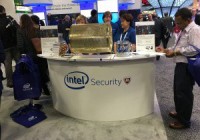Software Updates To Thump ‘Motivated’ Internet Of Things Hackers
SAN FRANCISCO — Gemalto exec David Etue hinged the success of the nascent Internet of Things industry — and its 30 billion connected devices in four years — to an efficient software update process. Because when 30 billion devices are connected to the Internet, there’s a lot that can go wrong … and fast. “Our adversaries are highly motivated,” Etue told attendees at the RSA Conference in San Francisco, a major annual gathering of security companies. “But if we can get a secure software update process right, at least we can make changes.” He added: “If we get this right, this puts us in a position for long-term success.” France-based Gemalto competes in the software application and secured devices market, and therefore has a big dog in the upcoming Internet of Things fight for market share. Although the IoT presents a huge market opportunity for tech and pure cybersecurity players, its mass scale also terrifies chief information security officers, Etue said. “We don’t generally intentionally put our IoT-connected devices in hostile territory,” he said. “We might put them on the local Starbucks ( SBUX ) Wi-Fi. … That’s not that scary when it’s your fitness meter. It’s pretty scary when it’s a pacemaker.” On the business side, retail stores use sensors to count shoppers — information hedge funds used to pay people to gather outside brick-and-mortar establishments. Farmers use devices to track the development of seeds. Tesla Motors ( TSLA ), Apple ( AAPL ), Toyota ( TM ), Alphabet ( GOOGL ) and Ford ( F ) are already racing toward autonomous vehicles. “So we’re seeing a lot of demand to monetize this data,” Etue said. But on the flip side, consumers are spooked after a fault in Fiat Chrysler ‘s ( FCAU ) Jeep Cherokee GPS system allowed it to be hacked, Rapid7 ( RPD ) researchers were able to hack baby monitors and Santa Cruz, Calif., residents protested smart meters. “We get really excited about the device, but forget about where that data is from and how it’s being managed,” Etue said. He suggests consumers and developers ask themselves a series of questions before taking on Internet of Things devices. Most of those questions center on how, where and what data are stored; whether it’s accessible by a third party; and who manages the accessibility. “We’re never going to get this right the first time,” he said. “We’re going to have to change.” Image provided by Shutterstock .
